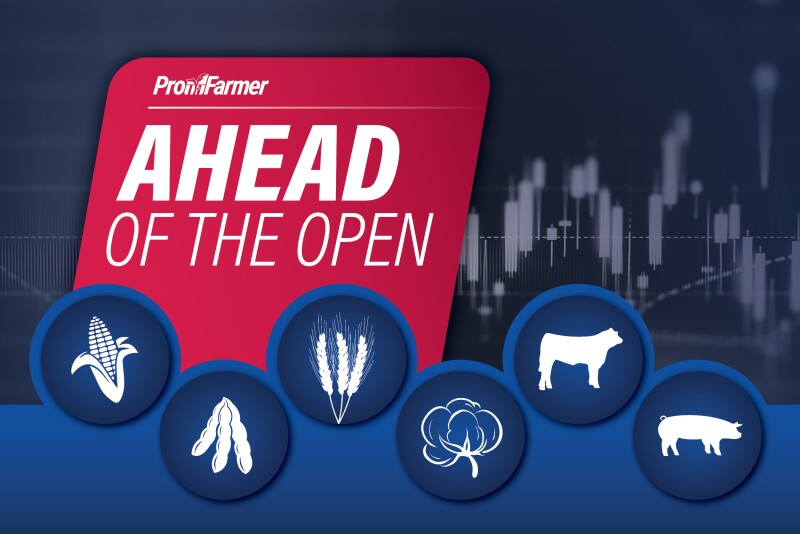GRAIN CALLS
Corn: 1 cent lower to 1 cent higher.
Soybeans: 1 to 3 cents higher.
Wheat: Winter wheat 5 to 8 cents higher; HRS 4 to 6 cents higher.
GENERAL COMMENTS: Volatility continues to run rampant across the marketplace, dictating much of the price action in the grain and soy markets. The fact that prices remain above the March lows is impressive considering equity futures are trading at more than one-year lows with several multi-hundred-point losses in a row. Until volatility subsides, it is difficult to give credence to price action. Corn, soybeans and wheat saw action on either side of unchanged overnight, wheat led strength this morning. Front-month made fresh four-year lows overnight while the U.S. dollar index saw modest losses.
President Donald Trump took to Truth Social Saturday to defend his sweeping new tariff policy after global markets plummeted and bipartisan criticism mounted. The tariffs — announced on what Trump dubbed “Liberation Day” — have triggered one of the sharpest market downturns since 2020, erasing trillions in market value. Trump called on Americans to “hang tough,” promising that although the new levies “won’t be easy,” the end result would be “historic.” He blamed foreign nations — especially China — for decades of economic imbalance, calling the U.S. a “whipping post.” Trump claimed over “FIVE TRILLION DOLLARS OF INVESTMENT” has poured into the country under his leadership.
Sunday on CNN’s State of the Union, USDA Secretary Brooke Rollins highlighted the administration’s commitment to supporting farmers who may face economic hardships due to retaliatory tariffs from trade partners. She assured viewers that USDA is prepared to implement aid measures similar to those used during previous trade disputes under Trump’s prior administration, such as tapping into the Commodity Credit Corporation (CCC) fund for economic relief. However, she acknowledged that the agency is still assessing the potential impacts of the new tariffs and does not yet have a clear timeline for releasing aid. Rollins emphasized that while the administration is working on infrastructure for potential relief programs, the full economic consequences of the tariffs may not be evident until later in the year, particularly for row crop farmers currently in planting season. She reiterated the importance of protecting American agriculture and ensuring farmers are supported through these challenging times.
China’s policymakers discussed measures over the weekend to stabilize the economy and markets in the face of U.S. tariffs, including whether to accelerate plans to unleash stimulus to bolster consumption, people familiar with the matter told Bloomberg. The measures will focus on boosting consumer spending, birth rate and subsidies for some exports, said the people. The regulators also discussed details of a stabilization fund to shore up its stock market, one of the people said. For now, officials have concluded China has built up a sufficient arsenal of tools to support its economy and tide over the current turmoil.
CORN: May corn futures saw action on either side of unchanged overnight. Bulls are eyeing resistance at $4.62, the 20-day moving average, which has capped all rallies since it failed in late February. Support lies at $4.58 3/4 then the psychological $4.50 mark on a turn lower.
SOYBEANS: May soybean futures saw modest strength overnight. Resistance stands at $9.91 then the psychological $10.00 mark on continued strength. Bulls are seeking to hold prices above support at $9.75, which is reinforced by Friday’s low of $9.70 1/4.
WHEAT: May SRW futures bounced overnight. Bulls are looking to overcome resistance at $5.38 1/4, the 10-day moving average. Additional strength finds resistance at $5.45. Support comes in at $5.28 1/4 then the March 28 low of $5.17 1/2 on a turn lower.
LIVESTOCK CALLS
CATTLE: Choppy/lower.
HOGS: Choppy/lower.
CATTLE: Live cattle futures and feeders are expected to open with a mostly weaker tone in a continuation of Friday’s limit-lower closes. Limits will be expanded to $9.75 for live cattle and $12.25 for feeders today. Both fats and feeders are now trading at steep discounts to their respective cash markets, which could limit further selling pressure. Markets are in liquidation mode across asset classes in response to last week’s tariff announcements but eventually prices will begin to focus on cash fundamentals again. Cash cattle trade was steady with the prior week going into Friday, while wholesale beef ended Friday mixed with Choice rising 8 cents to $338.45 while Select slid 66 cents to $317.18.
HOGS: Lean hog futures are expected to open with a mostly weaker tone in a continuation of last week’s selling pressure and ensuing technical breakdown. The fundamental outlook has not shifted much despite last week’s steep selloff, which could entice buyers to start the week. The CME lean hog index is down another 36 cents to $88.36 as of April 3, a fresh for-the-move low. Pork cutout rebounded $1.43 to $95.77 on Friday, led by strength in bellies. Equity market volatility and economic uncertainty could lead to consumers cutting costs at the meat counter, which would ultimately be long-term supportive for pork prices, especially as grilling season picks up here in the next couple weeks.

